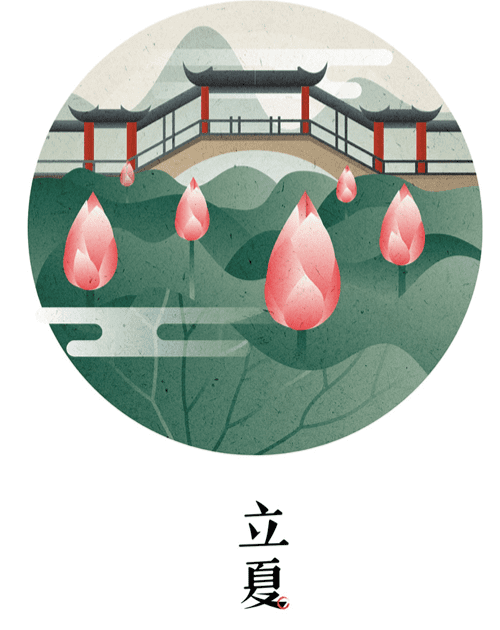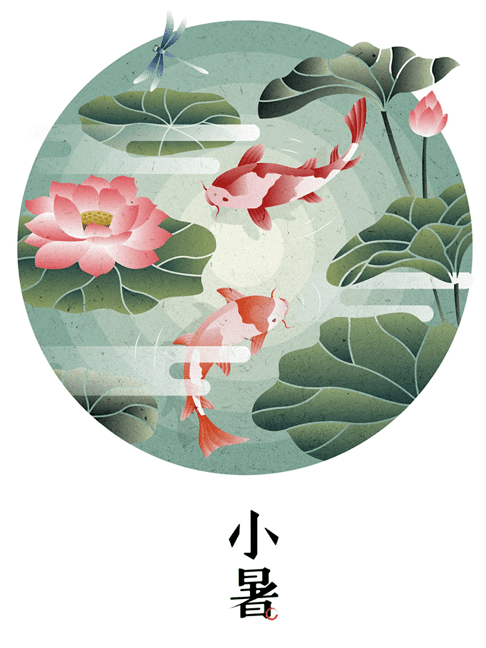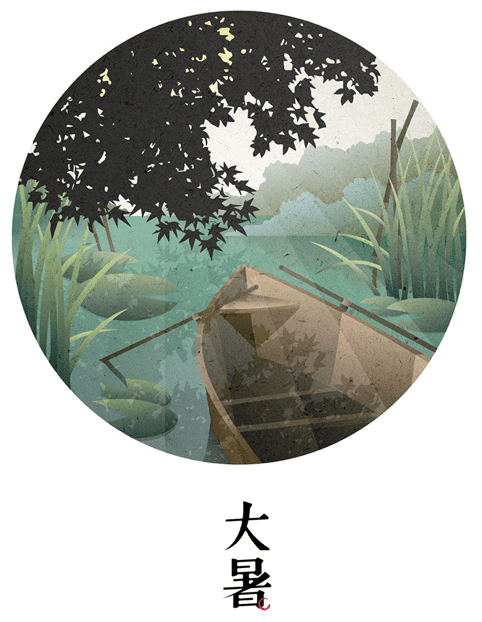
(Source: https://www.chinatravel.com/facts/chinese-solar-terms.htm)
The twenty-four solar terms, which originated in the Yellow River Basin, is the law of agricultural activities and climate change summarized by the ancient people in agricultural production practice. It provides a reference for the arrangement of agricultural affairs and farming activities. These twenty-four climatic laws have experienced a long period of development.
As shangshu yaodian recorded, in the Spring and Autumn Period (春秋, chūn qiū, 770 – 476 B.C.), by measuring the length of the Sun’s Shadow, the Summer Solstice (the sun shadow is the shortest, the sun reaches the northernmost point, and the longest daytime in the northern hemisphere) , the Winter Solstice (the longest day shadow, the sun reaches the southernmost point, the shortest daytime in the northern hemisphere) , the Spring Equinox and the Autumn Equinox (the sun is directly at the Equator and day and night are equal in length), these four solar terms are settled. At the end of the Warring States period (戰國, zhàn guó, 475 – 221 B.C.), four solar terms, the Beginning of Spring, the Beginning of Summer, the Beginning of Autumn and the Beginning of Winter were confirmed and recorded in Guanzi. In the early Western Han Dynasty, the twenty-four solar terms were determined.
At the very beginning, some of the solar terms were just a description of climate change in Lv’s Spring and Autumn. Huainanzi changed those descriptions to two characters words which became the official name of the solar terms.

Not all the features reflected in these names are directly related to the season. In addition to the eight solar terms that denote seasonal changes, there are also those related to temperature, such as 小暑 (xiǎoshǔ) Lesser Heat , 大暑 (dàshǔ) Greater Heat, 小寒 (xiǎohán) Lesser Cold, 大寒 (dàhán) Greater Cold , etc. Meteorological, such as 雨水 (yǔshuǐ) Rain Water, 寒露 (hánlù) Cold Dew, 霜降 (shuāngjiàng) Frost’s Descent, etc., as well as about farming activities, such as 小滿 (xiǎomǎn) Lesser Fullness of Grain, 芒種 (mángzhòng) Grain in Beard.
The 24 solar terms is related to the sun’s annual motion. Ancient Chinese divided the circle of the annual motion of the sun into 24 equal segments.
Today, the 24 solar terms still guide agricultural production. Although the solar term mainly corresponds to the climatic change of the Yellow River Basin, agricultural production in other regions still uses solar terms as a reference and has produced a number of farming proverbs. For example, with regard to the sowing of cotton, north China has the saying 清明早,小滿遲,穀雨種棉正當時 (Qīngmíng zǎo, xiǎomǎn chí, gǔyǔ zhòng mián zhèngdāngshí) “When sowing cotton, Grain Rain is the right time, because the time of Pure Brightness is too early but, when Lesser Fullness of Grain comes it is too late”, while in central China, Sichuan and other places, the farming proverb is 清明前,種好棉 (qīngmíng qián, zhòng hǎo mián) “Sowing cotton before Pure Brightness is the right time”.
The end of Greater Heat is near, and the summer phase determined by 24 solar terms is coming to an end. Let’s take a look at the summer solar term features in the 24 solar terms.

立夏 lìxià The Beginning of Summer May 5, 6 or 7
People used to place on the beginning of summer as temperature increased significantly, in the hot summer will, thunderstorm, entered the peak season to grow crops is one of the most important solar terms. After the beginning of summer, is critical period of early rice accumulates ZaiCha, sooner or later, and this time the rain comes and amount of rainfall, and closely related to the harvest in the future.

小滿 xiǎomǎn Lesser Fullness of Grain May 20,21 or 22
Since grain full, barley, wheat has been as a result, the summer harvest crops, such as grain gradually see full, but not yet mature, so called grain buds.

芒種 mángzhǒng Grain in Beard Jun. 5, 6 or 7
芒 (máng) is awn; beard, a slender, bristle-like appendage found on the spikelet of certain grasses. If wheat and barley’s spikelet have awn, it means they are mature. 種 can be a verb, read as zhòng, means to plant some grain ; it can be a noun, read as zhǒng, means the seed. Grain in beard-such as wheat and barley are mans crops to mature, and seed. Also means the paddy are ready to be planted. Also means at this time the paddy is ready to be planted.

夏至 xiàzhì The Summer Solstice Jun. 21 or 22
Every year on June 21st or 22nd, for the summer solstice, the sun and the tropic of cancer is in the northern hemisphere daylight on the longest day of the year, across the south, from sunrise to sunset is mostly for fourteen hours. Summer solstice day although the longest day, the sun Angle is the highest, but it’s not the hottest time of the year.

小暑 xiǎoshǔ Lesser Heat Jul. 6, 7 or 8
Before and after slight heat, I save much thunderstorms weather, is a severe thunderstorm weather phenomenon, often associated with short accompanied by strong winds, heavy rain, and sometimes hail.

大暑 dàshǔ Greater Heat Jul. 22, 23 or 24
Is the hottest period, the highest temperature, fastest growing, most parts of the most frequent drought, waterlogging, wind and rush in the harvest busy planting, drougt waterlogging orainage control stage and field management task in very heavy. Folk have drink Fu tea, sun fu jiang, burn Fuxiang custom, etc.
After reading this article, do you now understand the Chinese Solar Terms? Today is the “Greater Heat ” and the hot weather is coming to an end. If you want to know more about this topic, you can watch this video:
Reference:
- Jingyi Wang. Discussion on the Generation and Application of Twenty-four Solar Terms. Journal of Suihua Teachers College, 1999(04): 86-90.
- Le Zi. The Formation of the Twenty-four Solar Terms and the Origin of its Name. Journal of Shanxi University (Philosophy and Social Science Edition). 1989 (02): 39.
- Feng Lin. The Twenty-four Solar Terms Unique to China. Shandong Agricultural Sciences. 1975(01): 58-63.
- English translation reference of twenty-four solar terms: http://www.cma.gov.cn/2011xzt/essjqzt/jqhz/jqhz02/201312/t20131213_233952.html
- Introduction to summer solar terms: https://www.doc88.com/p-5435991260011.htm
- The Twenty-Four Solar Terms, knowledge in China of time and practices developed through observation of the sun’s annual motion: https://ich.unesco.org/en/RL/the-twenty-four-solar-terms-knowledge-in-china-of-time-and-practices-developed-through-observation-of-the-suns-annual-motion-00647?RL=00647
- All pictures of summer solar terms (author: Chen Mingjie) are from: https://www.behance.net/gallery/53309705/24-?tracking_source=search_projects_recommended%7C
